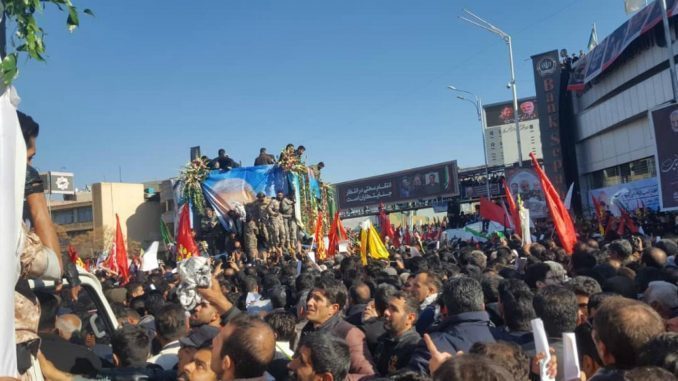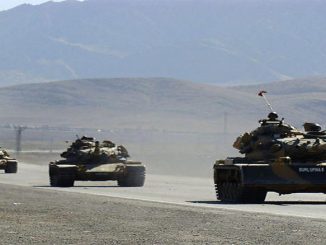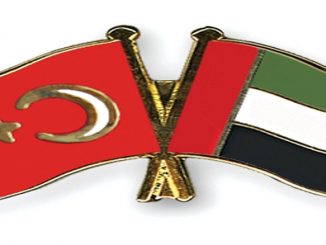
Burial reported postponed after local official says at least 50 people have been killed during procession in Kerman
A crush at the funeral procession of Qassem Soleimani in his hometown of Kerman on Tuesday has killed at least 50 people, the semi-official ISNA news agency has quoted a local official as saying.
Earlier, the Fars news said at least 40 people had died and around 213 others had been injured, citing an emergency services official.
Video footage purportedly of the incident’s aftermath circulated online showed several lifeless and bloody bodies lying on the ground among the crowds.
Pirhossein Koolivand, the head of Iran’s emergency medical services, said the injured were immediately transferred to hospital.
ISNA news agency said that the burial had been postponed but did not say how long any delay would last.
The remains of Soleimani had been expected to be buried at the martyrs’ cemetery between 2pm and 4pm (10.30 GMT to 12.30 GMT).
Speaking to Middle East Eye, Arash Rezai, a witness in Kerman, said: “The population of Kerman is one million and you can’t find anyone today staying at home.
“The crowd is huge and enormous and that’s why 32 people died.
“Even some people from other cities have come to Kerman for Haj Qassem. Many slept on the streets and Kerman’s cemetery last night in order not to miss the funeral and burial ceremony.”
Correspondents for the AFP news agency in Kerman said the streets were packed with mourners, while others took refuge on hillsides around the city.
Alireza Mardom-Nejad, also in Kerman, told MEE: “I think one or two million have attended the funeral in Kerman, especially from the provinces close to Kerman like Hormozgan.
“All the way to the cemetery, people accompanied the body of General Soleimani, but when we reached a narrow street under the name of ‘Shahid Beheshti,’ the crush occurred, leading to the death of some women and young men.”
The head of Bahonar hospital in central Kerman said the facility had received 13 bodies.
Twelve other people had been hospitalized, none of them with critical injuries, and another 40 people had been released with slight injuries, doctor Peyman Karnama told AFP.
Karnama added that more people killed in the crush had been taken to other medical centres in the city.
A grieving family was seen waiting in the yard of Bahonar hospital, where the names of casualties admitted were posted on a window at the entrance.
The remains of Soleimani arrived in Kerman for burial early on Tuesday, a day after millions of mourners gathered in the capital Tehran and the city of Qom in an emotionally charged funeral procession.
Earlier, state television had shown tens of thousands of people on Kerman’s streets, carrying Iranian flags and images of the general, as hymns of mourning sounded from loudspeakers.
Tuesday’s ceremonies mark the end of a three-day mourning period for the top Iranian military commander, who was assassinated on Friday in a US drone attack at Baghdad’s international airport.
Mourners converged from afar on Azadi Square where two flag-draped coffins were on display, with the second one reportedly containing the remains of Soleimani’s closest aide, Brigadier General Hossein Pourjafari.
Hossein Salami, the head of Iran’s Revolutionary Guards, told the crowds: “We will take revenge, a hard and definitive revenge.
“The martyr Qassem Soleimani is more dangerous to the enemy than Qassem Soleimani,” Salami told the mourners, many of them chanting “Death to America.”
“We’re here today to pay respects to the great commander of the holy defence,” said one of those in attendance who came from the southern city of Shiraz to attend the funeral in Kerman.
“Haj Qassem was not only loved in Kerman, or Iran, but also the whole world,” Hemmat Dehghan told the AFP news agency.
“The security of the whole world, Muslims, Shias, Iraq, Syria, Afghanistan and especially Iran, all owe it to him,” said the 56-year-old war veteran.
Basra marks Muhandis death
In Basra, thousands of Iraqis packed the streets of the southern city on Tuesday to mourn Iranian-backed militia leader Abu Mahdi al-Muhandis, who was killed in the same US air strike as Soleimani.
His body arrived at his hometown of Basra following several funeral processions elsewhere in Iraq and Iran.
It will be taken to the holy city of Najaf for burial following this final procession.
Muhandis was the top Iraqi adviser to Soleimani and de facto leader of Iraq’s Popular Mobilisation Forces (PMF), an umbrella body of paramilitary groups, giving him wide reaching influence over the country’s many powerful Iran-backed militias.
About 30,000 people thronged the streets of Basra waving Iraqi and militia flags and denouncing the US. Chants of “No, no America” and “No, no Israel” rang out.
“We will avenge Abu Mahdi al-Muhandis and Soleimani by forcing American troops to leave Iraq,” said cleric Muhsin al-Hakeem who stood by the convoy carrying the commander’s casket.
In a video will he left to be shared after his death, Muhandis called on his supporters to “perpetuate jihad”.
“I pray I spend the afterlife with… those I fought with, from Kuwait, to Iran, to Iraq. The Badr youth, and later the resistance against the occupation, and now the PMF youth.”
“I command you to take care of the Shias in the region and in the world,” he told his followers.
“Obey the Imam of the Umma Sayyid Khamenei,” he added, referring to Iranian Supreme Leader Ayatollah Ali Khamenei.
The assassination of Soleimani, 62, has heightened international concern about a new war in the Middle East and rattled financial markets.
Khamenei and top military commanders have said Iranian retaliation for the US action would match the scale of Soleimani’s killing but that it would be at a time and place of Tehran’s choosing.
Iraq’s parliament demanded on Sunday the government expel the 5,200 US troops stationed in the country in response to the drone attack which also killed top Iraqi militia figure Abu Mahdi al-Muhandis.
Reuters and other media reported on Monday that the US military had sent a letter to Iraqi officials informing them that US troops would be repositioned in preparation to leave, drawing a swift denial from the Pentagon.
“There’s been no decision whatsoever to leave Iraq,” Defence Secretary Mark Esper told reporters. “I don’t know what that letter is.”
US Army General Mark Milley, chairman of the Joint Chiefs of Staff, said the letter was a “poorly worded” draft document meant only to underscore increased movement by US forces.
The letter, addressed to the Iraqi Defence Ministry’s Combined Joint Operations, and confirmed as authentic by an Iraqi military source, had caused confusion about the future of the US military presence which has been in the country since Saddam Hussein was toppled in 2003.
Nato chief Jens Stoltenberg warned on Monday that Iran must avoid “further violence and provocations” after the alliance held emergency talks on the crisis.
The European Union, whose foreign ministers will hold emergency talks on the crisis Friday, said it was in both Iran and Iraq’s interests to “take the path of sobriety and not the path of escalation”.
Saudi Arabia, a US ally seen as vulnerable to Iranian counter strikes also appealed for calm after a “very dangerous” escalation.



